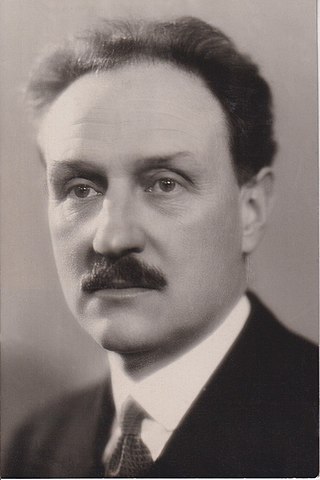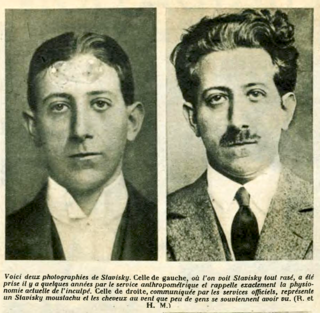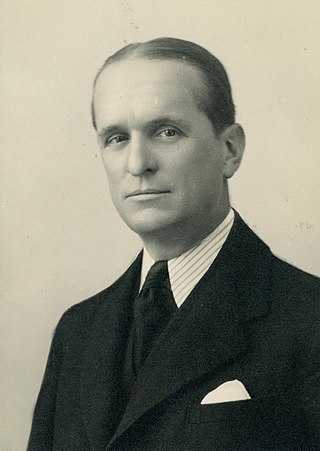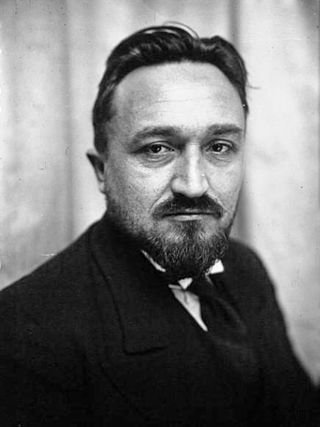
The Radical Party, officially the Republican, Radical and Radical-Socialist Party, is a liberal and social-liberal political party in France. Since 1971, to prevent confusion with the Radical Party of the Left (PRG), it has also been referred to as Parti radical valoisien, after its headquarters on the rue de Valois. The party's name has been variously abbreviated to PRRRS, Rad, PR and PRV. Founded in 1901, the PR is the oldest active political party in France.

Camille Chautemps was a French Radical politician of the Third Republic, three times President of the Council of Ministers.
The Popular Front was an alliance of French left-wing movements, including the communist French Communist Party (PCF), the socialist French Section of the Workers' International (SFIO) and the progressive Radical-Socialist Republican Party, during the interwar period. Three months after the victory of the Spanish Popular Front, the Popular Front won the May 1936 legislative election, leading to the formation of a government first headed by SFIO leader Léon Blum and exclusively composed of republican and SFIO ministers.

The Stavisky affair was a financial scandal in France in 1934, involving embezzler Alexandre Stavisky. The scandal had political ramifications for the Radical-Socialist government after it was revealed that Prime Minister Camille Chautemps had protected Stavisky, who died suddenly in mysterious circumstances.
The Cartel of the Left was the name of the governmental alliance between the Radical-Socialist Party, the socialist French Section of the Workers' International (SFIO), and other smaller left-republican parties that formed on two occasions in 1924 to 1926 and in 1932 to 1933. The Cartel des gauches twice won general elections, in 1924 and in 1932. The first Cartel was led by Radical-Socialist Édouard Herriot, but the second was weakened by parliamentary instability and was without one clear leader. Following the 6 February 1934 crisis, President of the Council Édouard Daladier had to resign, and a new Union Nationale coalition, led by the right-wing Radical Gaston Doumergue, took power.

Serge Alexandre Stavisky was a French financier and embezzler whose actions created a political scandal that became known as the Stavisky Affair.

The French Social Party was a French nationalist political party founded in 1936 by François de La Rocque, following the dissolution of his Croix-de-Feu league by the Popular Front government. France's first right-wing mass party, prefiguring the rise of Gaullism after the Second World War, it experienced considerable initial success but disappeared in the wake of the fall of France in 1940 and was not refounded after the war.

The Francist Movement was a French fascist and anti-semitic league created by Marcel Bucard in September 1933 that edited the newspaper Le Francisme. Mouvement franciste reached a membership of 10,000 and was financed by the Italian dictator, Benito Mussolini. Its members were deemed the francistes or Chemises bleues (Blueshirts) and gave the Roman salute.

François de La Rocque was the leader of the French right-wing league the Croix de Feu from 1930 to 1936 before he formed the more moderate nationalist French Social Party (1936–1940), which has been described by several historians, such as René Rémond and Michel Winock, as a precursor of Gaullism.
The far-right leagues were several French far-right movements opposed to parliamentarism, which mainly dedicated themselves to military parades, street brawls, demonstrations and riots. The term ligue was often used in the 1930s to distinguish these political movements from parliamentary parties. After having appeared first at the end of the 19th century, during the Dreyfus affair, they became common in the 1920s and 1930s, and famously participated in the 6 February 1934 crisis and riots which overthrew the second Cartel des gauches, i.e. the center-left coalition government led by Édouard Daladier.
The far-right tradition in France finds its origins in the Third Republic with Boulangism and the Dreyfus affair. In the 1880s, General Georges Boulanger, called "General Revenge", championed demands for military revenge against Imperial Germany as retribution for the defeat and fall of the Second French Empire during the Franco-Prussian War (1870–71). This stance, known as revanchism, began to exert a strong influence on French nationalism. Soon thereafter, the Dreyfus affair provided one of the political division lines of France. French nationalism, which had been largely associated with left-wing and Republican ideologies before the Dreyfus affair, turned after that into a main trait of the right-wing and, moreover, of the far right. A new right emerged, and nationalism was reappropriated by the far-right who turned it into a form of ethnic nationalism, blended with anti-Semitism, xenophobia, anti-Protestantism and anti-Masonry. The Action française, first founded as a journal and later a political organization, was the matrix of a new type of counter-revolutionary right-wing, which continues to exist today. During the interwar period, the Action française (AF) and its youth militia, the Camelots du Roi, were very active. Far right leagues organized riots.

Paul Henri Marie Joseph Marchandeau,, was a lawyer, journalist and French Radical Socialist politician. He was awarded the Croix de guerre and the Légion d'honneur for his actions during World War I. From 1925 until 1942, he was the mayor of Reims. During the 1930s, he was, successively, French minister of finance, minister of the interior, minister of justice, and minister of the budget.

The Croix-de-Feu was a nationalist French league of the Interwar period, led by Colonel François de la Rocque (1885–1946). After it was dissolved, as were all other leagues during the Popular Front period (1936–38), La Rocque established the Parti social français (PSF) to replace it.
Robert Soucy is an American historian, specializing in French fascist movements between 1924 and 1939, French fascist intellectuals Maurice Barrès and Pierre Drieu La Rochelle, European fascism, twentieth-century European intellectual history, and Marcel Proust's aesthetics of reading.

The French National-Collectivist Party, originally known as the French National Communist Party, was a minor political group active in the French Third Republic and reestablished in occupied France. Its leader in both incarnations was the sports journalist Pierre Clémenti. It espoused a "national communist" platform noted for its similarities with fascism, and popularized racial antisemitism. The group was also noted for its agitation in support of pan-European nationalism and rattachism, maintaining contacts in both Nazi Germany and Wallonia.

Albert François Marie Dalimier was a French politician. Between 1932 and 1934 he was Minister of Labor, Minister of the Colonies (twice) and Minister of Justice in four of the short-lived cabinets of that period. He was forced to resign during the scandal of the Stavisky Affair in January 1934, since his advice as Minister of Labor may have made the embezzlement possible.

Eugène Frot was a French politician who was Minister of Merchant Marine (twice), Minister of Labor and Social Assurance (twice) and Minister of the Interior in various short-lived cabinets between December 1932 and February 1934. While he was Minister of Interior, right-wing groups organized street demonstrations in Paris on 6 February 1934 in which the police shot dead fourteen people. In the aftermath the cabinet was forced to resign. Frot supported Republican institutions, but by the late 1930s was a committed pacifist. In July 1940 he voted for the constitutional change that established the collaborationist Vichy government. As a result, he was barred from politics after the war.

Interwar France covers the political, economic, diplomatic, cultural and social history of France from 1918 to 1939. France suffered heavily during World War I in terms of lives lost, disabled veterans and ruined agricultural and industrial areas occupied by Germany as well as heavy borrowing from the United States, Britain, and the French people. However, postwar reconstruction was rapid, and the long history of political warfare along religious lines of the time was ended.
French nationalism during World War II experienced divided attitudes towards the Nazi occupier, the Vichy government and the resistance.













